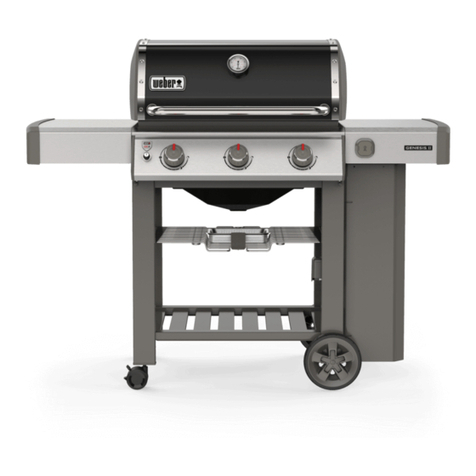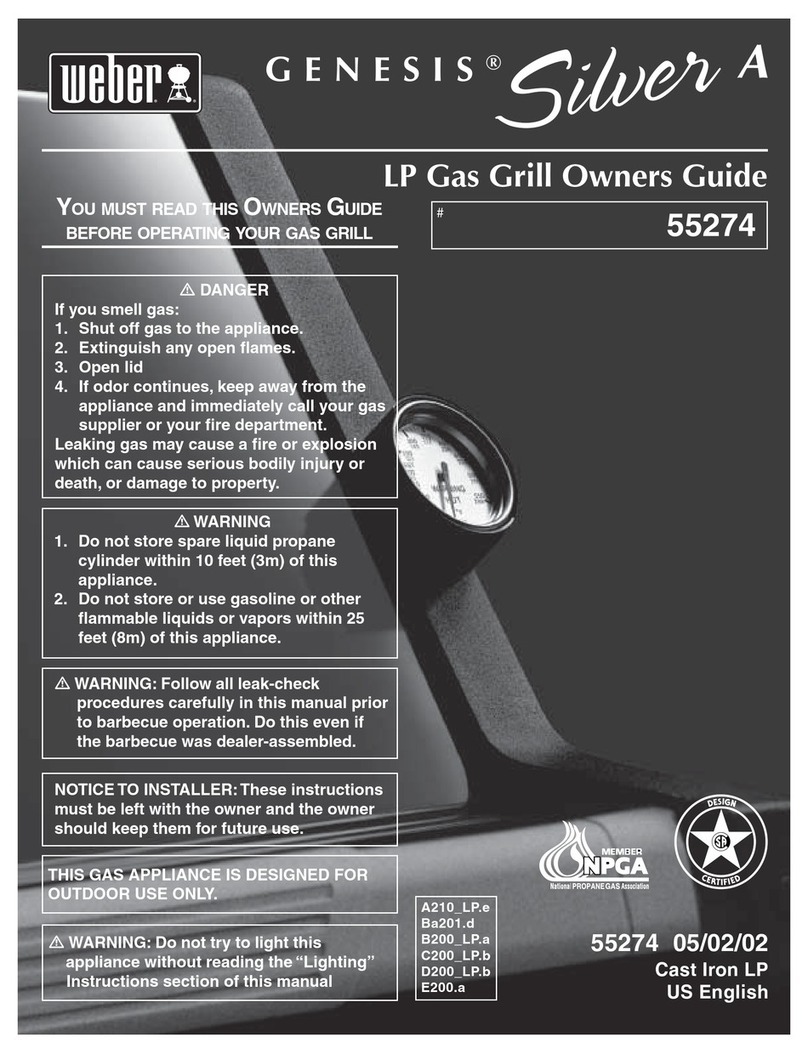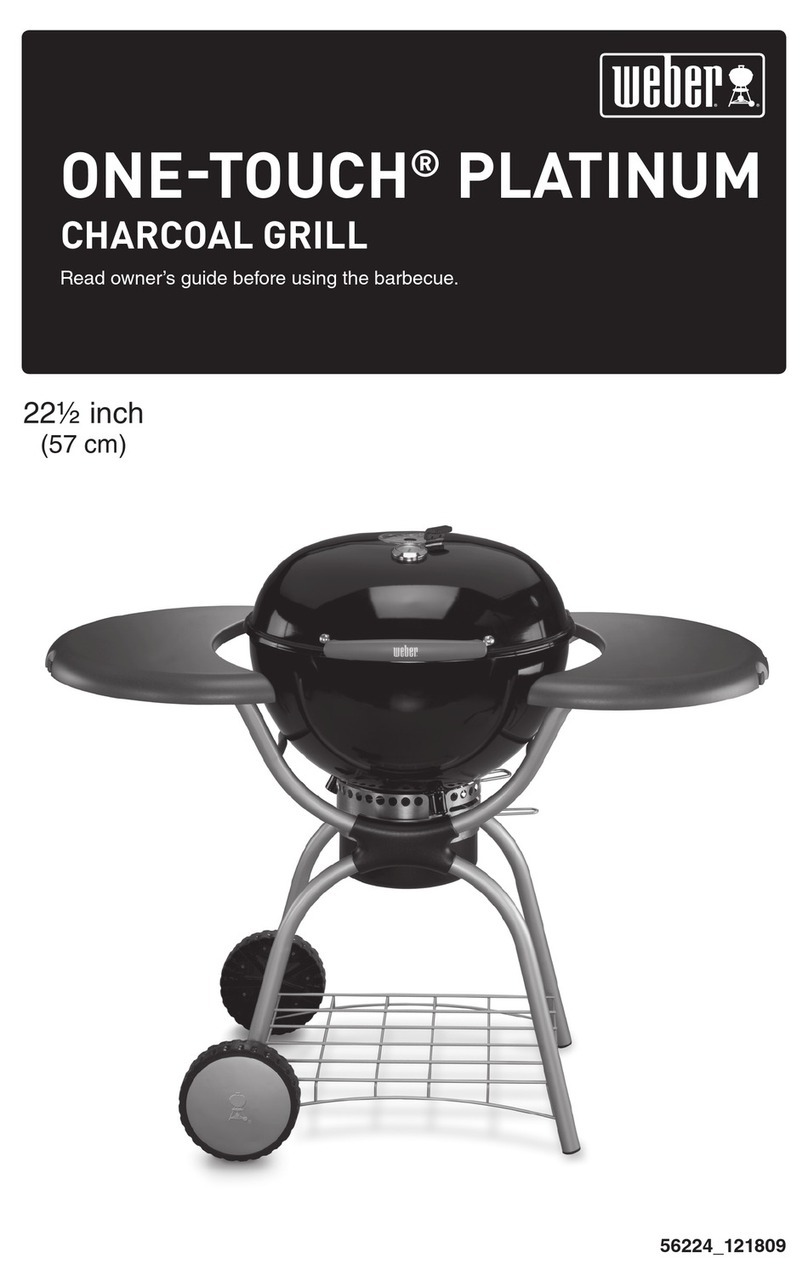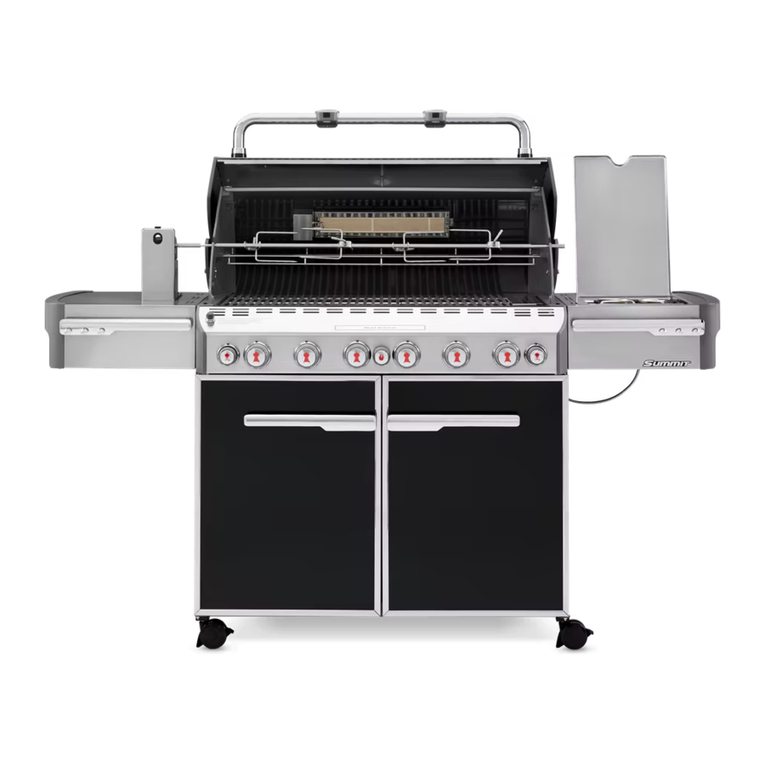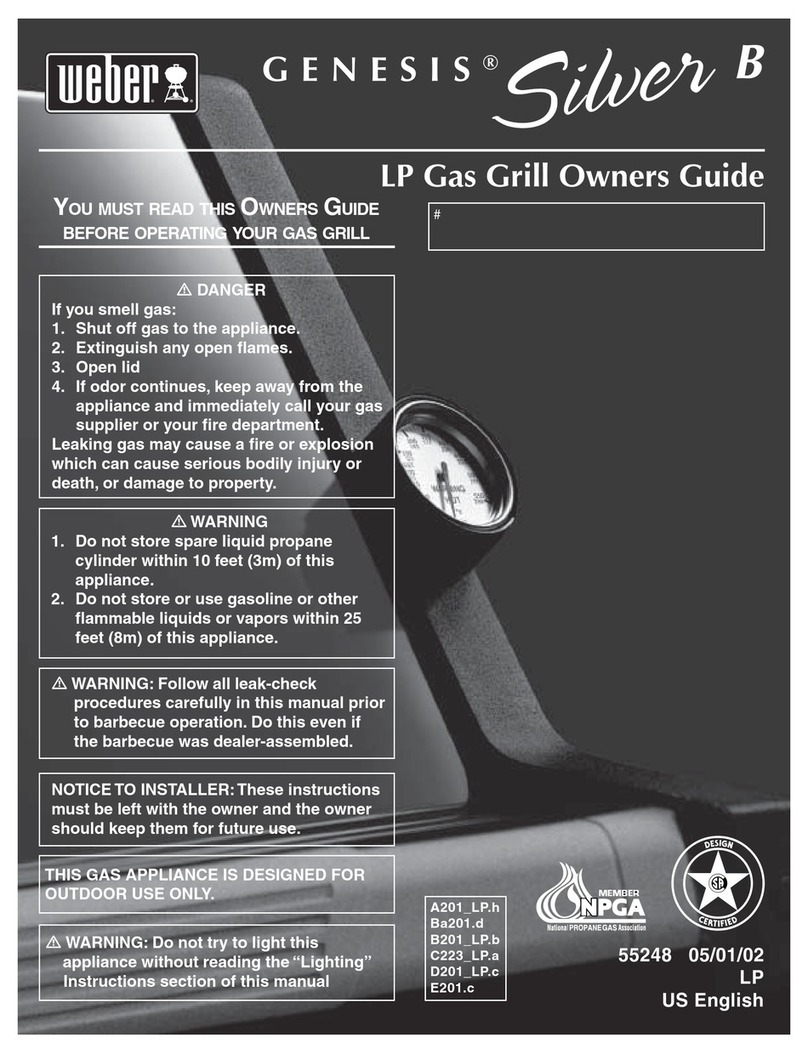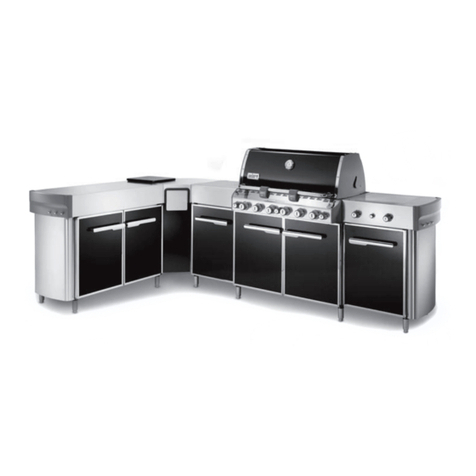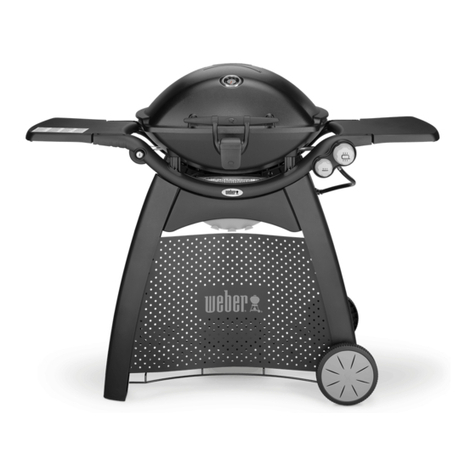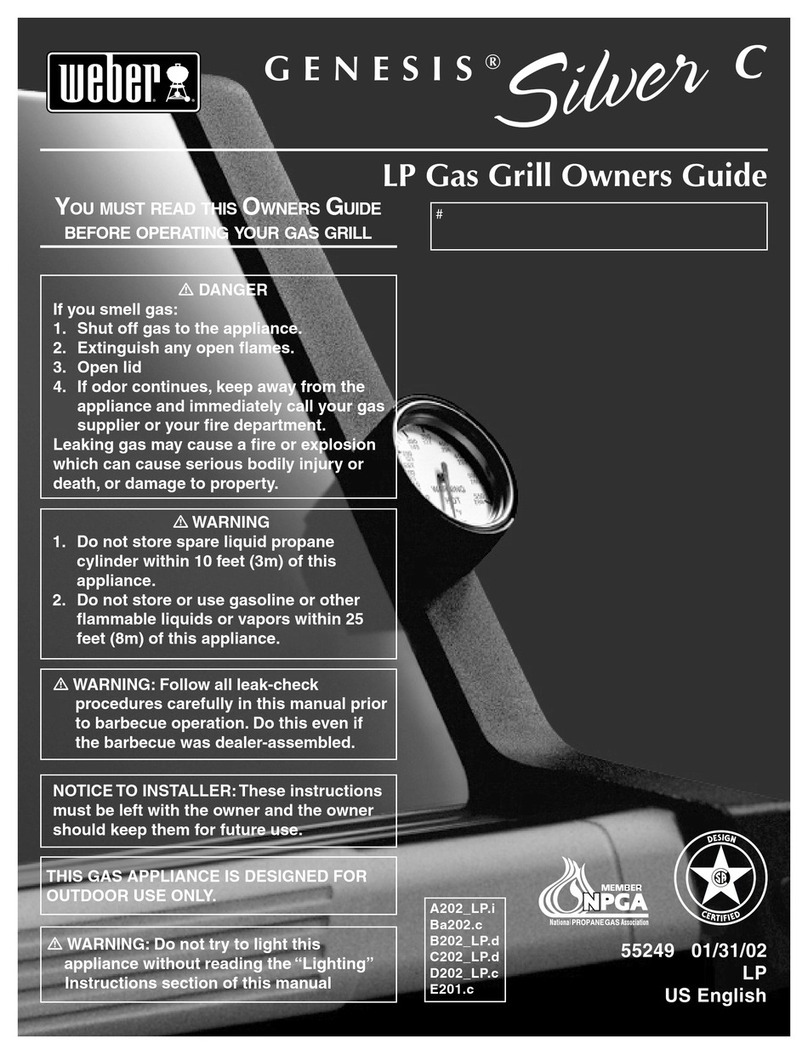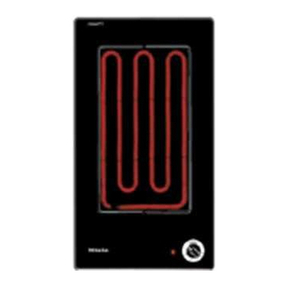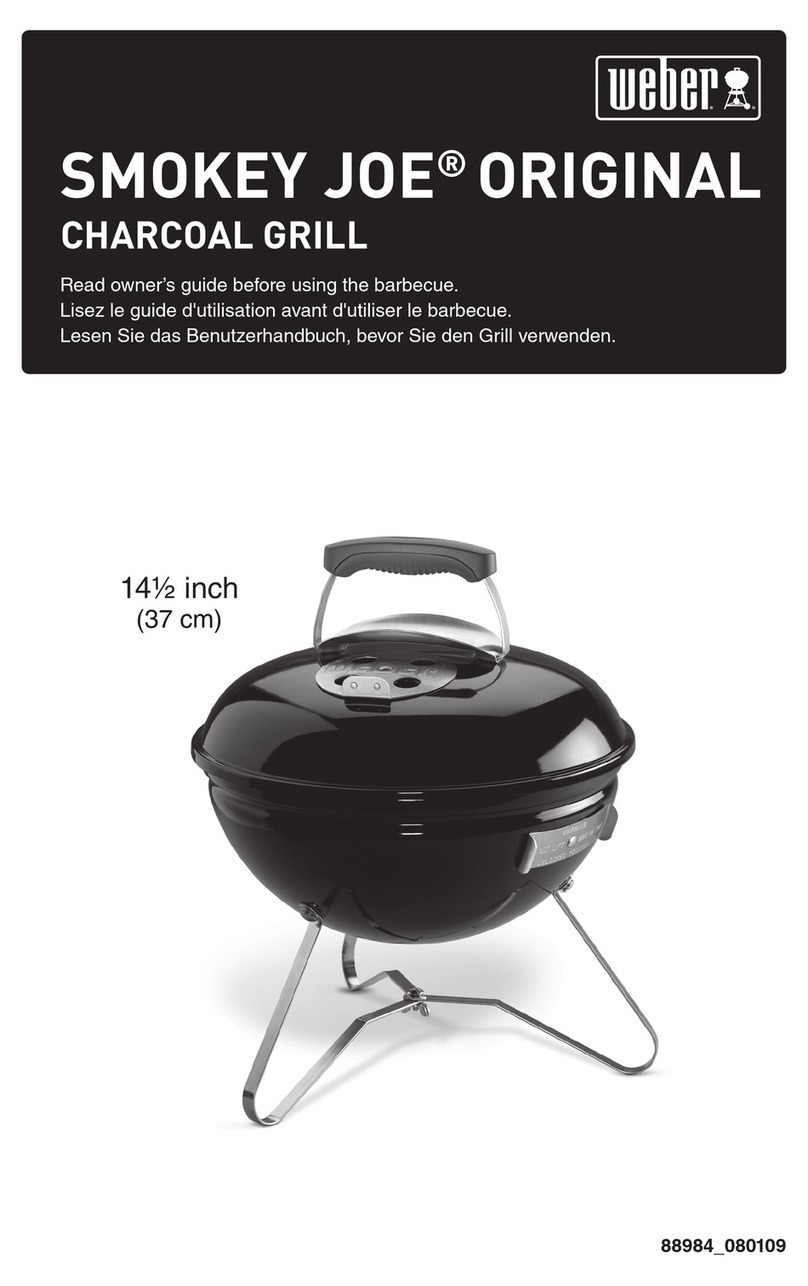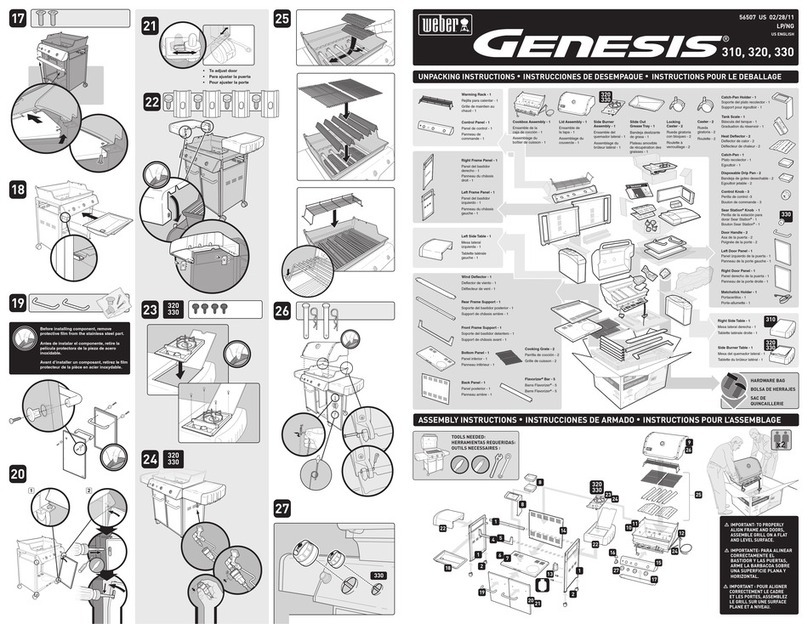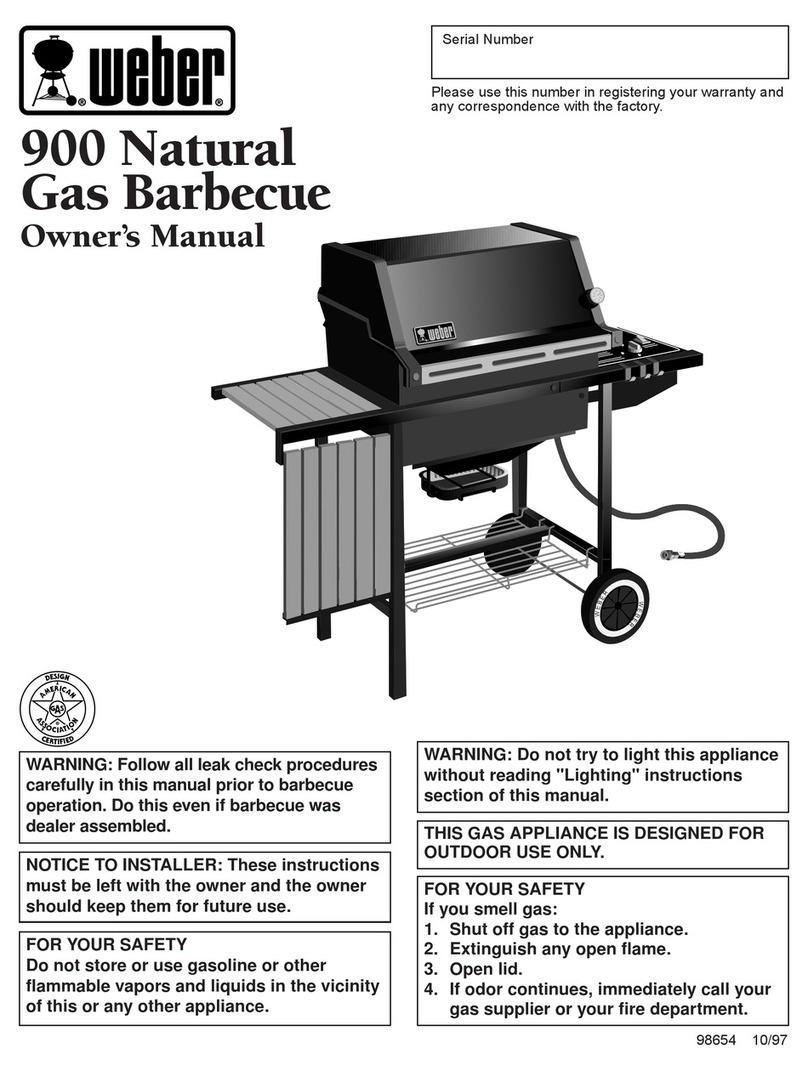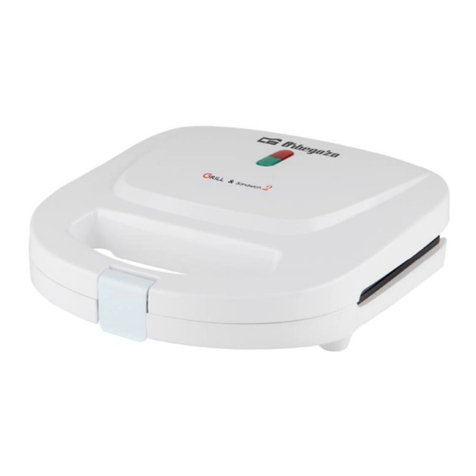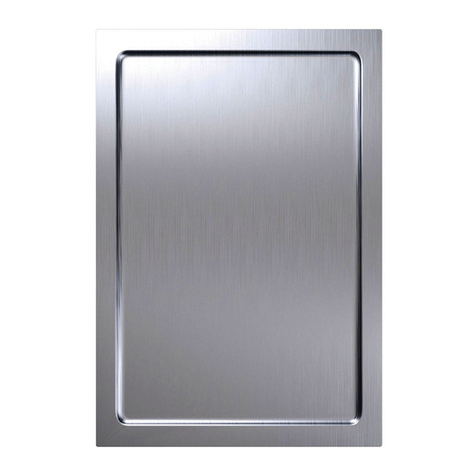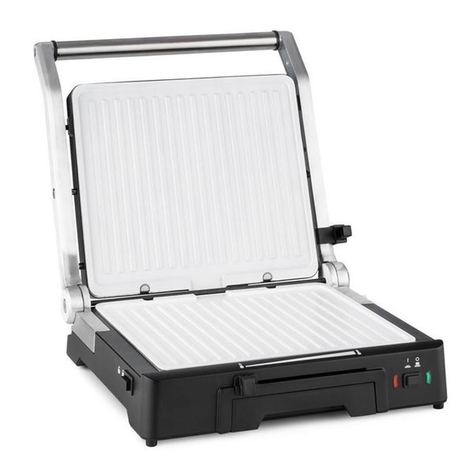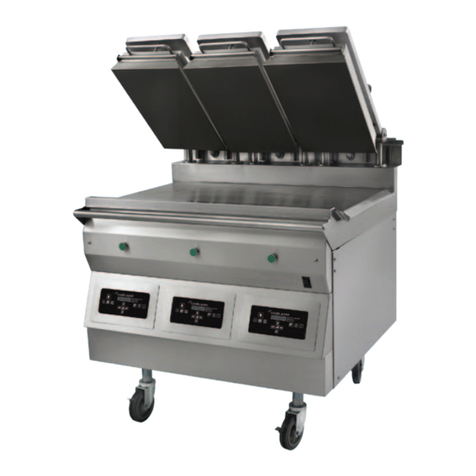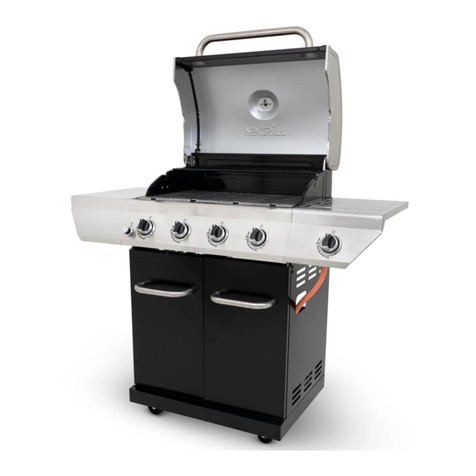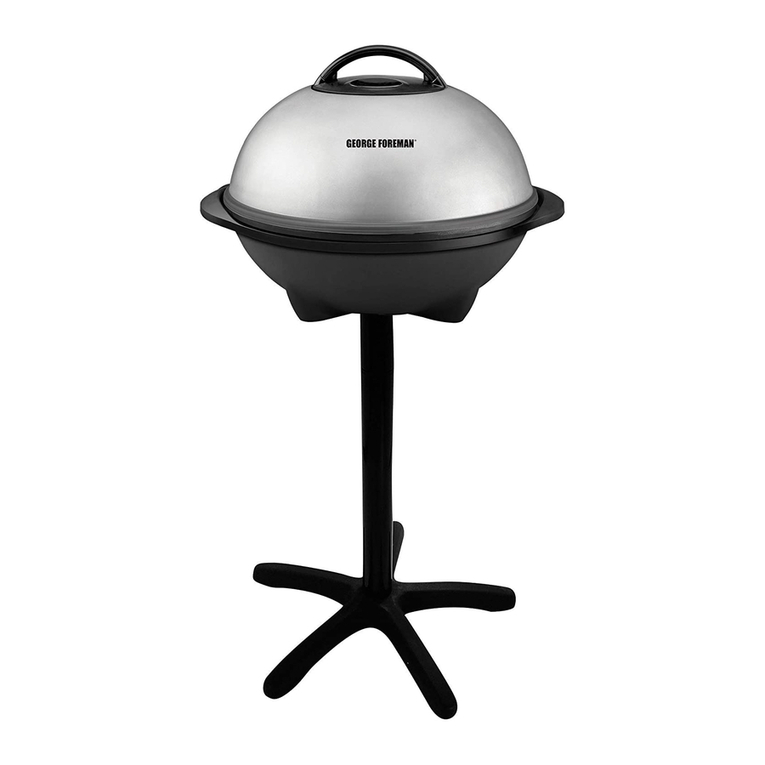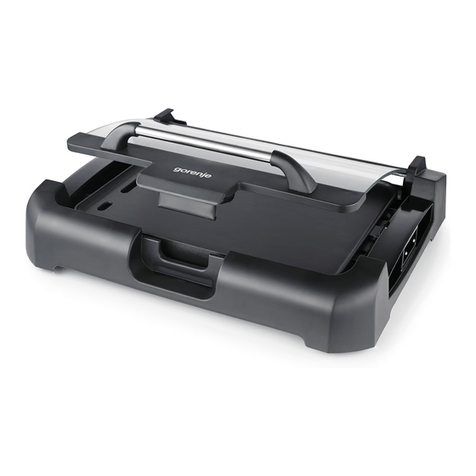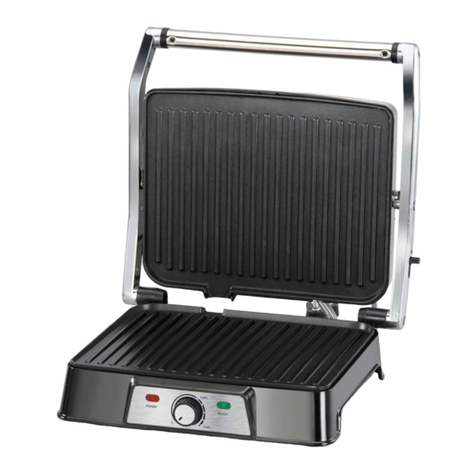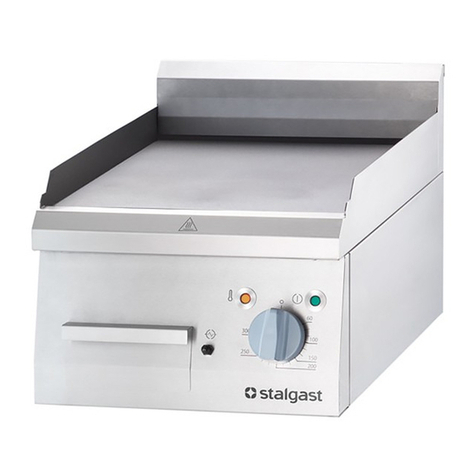
WWW.WEBER.COM 3
WARRANTY TABLE OF CONTENTS
The grills illustrated in this Owner’s Guide may vary slightly
from the model purchased.
Thank you for purchasing a WEBER product. Weber-Stephen Products
LLC, 1415 S. Roselle Road, Palatine, Illinois 60067 (“WEBER”) prides
itself on delivering a safe, durable, and reliableproduct.
This is WEBER’s Voluntary Warranty provided to you at no extra
charge. It contains the information you will need to have your WEBER
product repaired in the unlikely event of a failure or defect.
Pursuant to applicable PRC laws, the customer has several rights
in case the product is defective. Those rights may include repair,
replacement, or refund of the defective product, as appropriate
depending on the actual circumstance. Those rights include
supplementary performance or replacement, abatement of the
purchasing price, and compensation. In the European Union, for
example, this would be a two-year statutory warranty starting on
the date of the handover of the product. These and other statutory
rights remain unaected by this warranty provision. In fact, this
warranty grants additional rights to the Owner that are independent
from statutory warranty provisions.
WEBER’S VOLUNTARY WARRANTY
WEBER warrants, to the purchaser of the WEBER product (or in
the case of a gift or promotional situation, the person for whom
it was purchased as a gift or promotional item), that the WEBER
product is free from defects in material and workmanship for the
period(s) of time specified below when assembled and operated in
accordance with the accompanying Owner’s Manual. (Note: If you
lose or misplace your WEBER Owner’s Manual, a replacement is
available online at www.weber.com, or such country-specific website
to which Owner may be redirected.) Under normal, private single
family home or apartment use and maintenance, WEBER agrees
within the framework of this warranty to repair or replace defective
parts within the applicable time periods, limitations, and exclusions
listed below. TO THE EXTENT ALLOWABLE BY APPLICABLE LAW,
THIS WARRANTY IS EXTENDED ONLY TO THE ORIGINAL PURCHASER
WHO HAS PURCHASED WEBER PRODUCT FROM WEBER'S
AUTHORIZED DEALERS AND RETAILERS AND IS NOT TRANSFERABLE
TO SUBSEQUENT OWNERS, EXCEPT IN THE CASE OF GIFTS AND
PROMOTIONAL ITEMS AS NOTED ABOVE.
OWNER’S RESPONSIBILITIES UNDER THIS WARRANTY
To ensure trouble-free warranty coverage, it is important (but it
is not required) that you register your WEBER product online at
www.weber.com, or such country-specific website to which Owner
may be redirected. Please also retain your original sales receipt and/
or invoice. Registering your WEBER product confirms your warranty
coverage and provides a direct link between you and WEBER in case
we need to contact you.
The above warranty only applies if the Owner takes reasonable
care of the WEBER product by following all assembly instructions,
usage instructions, and preventative maintenance as outlined in the
accompanying Owner’s Manual, unless the Owner can prove that the
defect or failure is independent of non-compliance with the above
mentioned obligations. If you live in a coastal area, or have your
product located near a pool, maintenance includes regular washing
and rinsing of the exterior surfaces as outlined in the accompanying
Owner’s Manual.
WARRANTY HANDLING / EXCLUSION OF WARRANTY
If you believe that you have a part which is covered by this Warranty,
please contact WEBER Customer Service using the contact
information on our website (www.weber.com, or such country-
specific website to which Owner may be redirected). WEBER will,
upon investigation, repair or replace (at its option) a defective
part that is covered by this Warranty. In the event that repair or
replacement are not possible, WEBER may choose (at its option) to
replace the grill in question with a new grill of equal or greater value.
WEBER may ask you to return parts for inspection, shipping charges
to be pre-paid.
This WARRANTY lapses if there are damages, deteriorations,
discolorations, and/or rust for which WEBER is not responsible
caused by:
• Abuse, misuse, alteration, modification, misapplication, vandalism,
neglect, improper assembly or installation, and failure to properly
perform normal and routine maintenance;
• Insects (such as spiders) and rodents (such as squirrels), including
but not limited to damage to burner tubes and/or gas hoses;
• Exposure to salt air and/or chlorine sources such as swimming
pools and hot tubs/spas;
• Severe weather conditions such as hail, hurricanes, earthquakes,
tsunamis or surges, tornadoes or severe storms.
The use and/or installation of parts on your WEBER product that are
not genuine WEBER parts will void this Warranty, and any damages
that result hereby are not covered by this Warranty. Any conversion
of a gas grill not authorized by WEBER and performed by a WEBER
authorized service technician will void this Warranty.
PRODUCT WARRANTY PERIODS
Cookbox:
5 years, no rust through/burn through
(2 years paint excluding fading or discolouration)
Lid assembly:
5 years, no rust through/burn through
(2 years paint excluding fading or discolouration)
Stainless steel burner tubes:
5 years, no rust through/burn through
Porcelain-enamelled cast iron cooking grates:
5 years, no rust through/burn through
Plastic components:
5 years, excluding fading or discolouration
All remaining parts:
2 years
Warranty period commences from the date of sales receipt or invoice.
You will be required to present the original sales receipt or invoice in
claiming the warranty.
DISCLAIMERS
APART FROM THE WARRANTY AND DISCLAIMERS AS DESCRIBED IN
THIS WARRANTY STATEMENT, THERE ARE EXPLICITLY NO FURTHER
WARRANTY OR VOLUNTARY DECLARATIONS OF LIABILITY GIVEN
HERE WHICH GO BEYOND THE STATUTORY LIABILITY APPLYING TO
WEBER. THE PRESENT WARRANTY STATEMENT ALSO DOES NOT
LIMIT OR EXCLUDE SITUATIONS OR CLAIMS WHERE WEBER HAS
MANDATORY LIABILITY AS PRESCRIBED BY STATUTE.
NO WARRANTIES SHALL APPLY AFTER THE APPLICABLE PERIODS
OF THIS WARRANTY. NO OTHER WARRANTIES GIVEN BY ANY
PERSON, INCLUDING A DEALER OR RETAILER, WITH RESPECT TO
ANY PRODUCT (SUCH AS ANY “EXTENDED WARRANTIES”), SHALL
BIND WEBER. THE EXCLUSIVE REMEDY OF THIS WARRANTY IS
REPAIR OR REPLACEMENT OF THE PART OR PRODUCT, UNLESS
OTHERWISE MANDATORILY REQUIRED BY APPLICABLE LAW.
IN NO EVENT UNDER THIS VOLUNTARY WARRANTY SHALL
RECOVERY OF ANY KIND BE GREATER THAN THE AMOUNT OF THE
PURCHASE PRICE OF THE WEBER PRODUCT SOLD.
YOU ASSUME THE RISK AND LIABILITY FOR LOSS, DAMAGE, OR
INJURY TO YOU AND YOUR PROPERTY AND/OR TO OTHERS AND
THEIR PROPERTY ARISING OUT OF THE MISUSE OR ABUSE OF THE
PRODUCT OR FAILURE TO FOLLOW INSTRUCTIONS PROVIDED BY
WEBER IN THE ACCOMPANYING OWNER’S MANUAL.
PARTS AND ACCESSORIES REPLACED UNDER THIS WARRANTY ARE
WARRANTED ONLY FOR THE BALANCE OF THE ABOVE MENTIONED
ORIGINAL WARRANTY PERIOD(S).
THIS WARRANTY APPLIES TO PRIVATE SINGLE FAMILY HOME OR
APARTMENT USE ONLY AND DOES NOT APPLY TO WEBER GRILLS
USED IN COMMERCIAL, COMMUNAL OR MULTI-UNIT SETTINGS SUCH
AS RESTAURANTS, HOTELS, RESORTS, OR RENTAL PROPERTIES.
WEBER MAY FROM TIME TO TIME CHANGE THE DESIGN OF ITS
PRODUCTS. NOTHING CONTAINED IN THIS WARRANTY SHALL
BE CONSTRUED AS OBLIGATING WEBER TO INCORPORATE SUCH
DESIGN CHANGES INTO PREVIOUSLY MANUFACTURED PRODUCTS,
NOR SHALL SUCH CHANGES BE CONSTRUED AS AN ADMISSION
THAT PREVIOUS DESIGNS WERE DEFECTIVE.
Refer to International Business Units list at the end of this Owner’s
Manual for additional contact information.
WARNINGS ................................2
WARRANTY................................3
TABLE OF CONTENTS .......................3
PARTS LIST................................4
ASSEMBLY.................................5
WEBER Q 1000 EXPLODED VIEW .............6
WEBER Q 1200 EXPLODED VIEW .............7
WEBER Q 2000 EXPLODED VIEW .............8
WEBER Q 2200 EXPLODED VIEW .............9
IMPORTANT INFORMATION ABOUT
LP GAS & LP GAS CONNECTIONS ............10
WHAT IS LP GAS? .............................................10
SAFE HANDLING TIPS FOR CYLINDERS..........................10
STORAGE AND NON-USE GUIDELINES...........................10
REGULATOR CONNECTIONS & REQUIREMENTS ...................10
CONNECTING THE REGULATOR
TO THE CYLINDER .........................11
WHAT IS A REGULATOR?.......................................11
CONNECTING THE HOSE TO THE VALVE..........................11
CONNECTING THE REGULATOR TO THE CYLINDER ................11
PREPARING TO USE YOUR GRILL ............12
WHAT IS A LEAK CHECK? ......................................12
CHECKING FOR GAS LEAKS AFTER CONNECTING A CYLINDER......12
DISCONNECTING THE REGULATOR ..........14
DISCONNECTING THE REGULATOR FROM THE CYLINDER ..........14
SAFETY CHECKS BEFORE
USING YOUR GRILL ........................15
SAFETY FIRST................................................15
REMOVABLE CATCH PAN AND DISPOSABLEDRIPPAN.............15
HOSE INSPECTION ............................................15
BURNER IGNITION & USAGE ................16
METHODS OF BURNER IGNITION................................16
BURNER IGNITION ............................................16
TO EXTINGUISH BURNER ......................................16
LIGHTING WITH A MATCH ......................................17
TO EXTINGUISH BURNER ......................................17
BARBECUING TIPS & HELPFUL HINTS .......18
TIPS & HINTS ................................................18
PREHEATING .................................................18
COVERED COOKING ...........................................18
GREASE COLLECTION SYSTEM .................................18
TROUBLESHOOTING .......................19
ANNUAL MAINTENANCE ...................20
KEEPING YOUR WEBER GAS GRILL IN TIP-TOP SHAPE.............20
BURNER FLAME PATTERN .....................................20
WEBER SPIDER/INSECT SCREEN(S).............................20
BURNER TUBE PORTS.........................................20
BURNER TUBE CLEANING OR REPLACEMENT ....................21
ROUTINE MAINTENANCE ...................22
BEAUTIFUL—INSIDE AND OUT..................................22
CLEANING THE OUTSIDE OF THE GRILL .........................22
CLEANING THE INSIDE OF THE GRILL ...........................22
IGNITION SYSTEM OPERATIONS ................................23
MAINTAINING THE PUSH BUTTON IGNITION SYSTEM ..............23
MAINTAINING THE ELECTRONIC IGNITION SYSTEM................23


